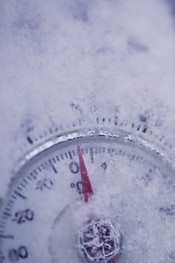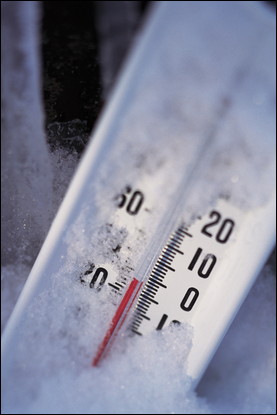 Plummeting temperatures, followed by a rapid thaw, can cause all sorts of problems for the unready home. |
Winter is filled with dangers and hazards for your home. Frozen pipes. Ice dams. Basement and foundation leaks. It’s not just the freak snow storm that leaves you without power that should be a cause for concern. It’s the rise and fall of the temperatures that present a silent, creeping disaster just waiting to strike. The freeze/thaw cycle that so many homes across the country experience over the course of the Winter months may be a challenge, but with the right information in hand you and your home can emerge into Spring unscathed.
Here are some things to watch out for during the freeze-thaw cycles:
Frozen Pipes and Bursting Pipes
Here’s the short story: When temperatures dip, unprotected pipes freeze. Or rather, the water in the pipes freeze. That ice expands, creating a burst in the pipe. The problem is, you won’t notice the burst pipe until it’s too late. That is, when the temperatures rise again, the ice melts and an unchecked stream of water begins pouring from the leak, soaking the room and everything in it.
Solution: There are two simple solutions to the frozen pipe situation. One is to prevent the pipes from freezing in the first place. Watch this video to learn how. The other is to know what to do if a pipe does burst. This article will guide you through those steps.
Ice Dams
Ice dams are a nuisance on many levels. Literally. They form on the overhanging section of your roof and prevent melting snow and ice from getting to the gutters and draining properly. Instead, that water gets backed up into the seams of the roof, causing water damage.
To prevent ice dams, you need to keep the temperature of those eaves the same as the rest of the roof. How? You can increase ventilation (using ridge vents and soffit vents), adding insulation where it’s lacking and sealing up leaks.
Removing existing ice dams is another matter altogether. It should go without saying that getting onto an ice-filled roof is seriously dangerous. Hacking away at ice on the roof with an axe or shovel isn’t going to do your roof any favors, either. Instead, try using a long roof rake to pull any melting snow off the roof while standing on the ground. This will eliminate the source of the melting that is infiltrating through the roof.
Foundation Protection
You’re not going to get all that snow, ice and icicles from the roof all the winter long. Some of it is going to melt into water and come down on its own. What you want to prevent, however, is all that snow and ice turning into water that infiltrates the foundation.
To address this potential issue, consider putting some backfill up against the foundation to create a slope away from the home. As the snow on the roof melts, the slope will carry the water away from the foundation.
Air and Water Infiltration
The freezing of water and expansion of ice can cause flashing to come undone, providing an entryway for water. This is more of a spring or fall season project, but you’ll want to check around chimneys and anywhere else there is flashing to keep water from getting into the attic.
Want to learn more about chimney and roof inspection? Read these:
How to Inspect and Repair Your Roof
How to Prevent and Fix Roof Leaks
For a full look at winterizing your home and keeping the cold air out, watch these videos.




























